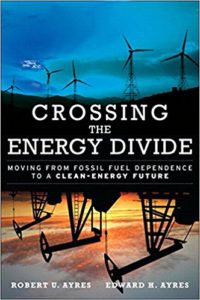Crossing the Energy Divide
by Robert Ayres and Edward Ayres, 2010
This book is really relevant for some of my energy research, which focuses on short- to medium-term energy solutions for a world seeking to transition from a dirty fossil-fuel past to a clean renewable-energy future. I actually use a quote from this book in my talks on combined heat and power (or cogeneration): “If our goal is to reduce carbon emissions on a large scale as quickly as possible, the most effective way is to invest in cogeneration.”
I particularly like the sections on combined heat and power and the water-energy connection. Suggested for individuals concerned with effective energy policy.
Quotes I liked from the book:
1. “If our goal is to reduce carbon emissions on a large scale as quickly as possible, the most effective way is to invest in ‘cogeneration.'” (pg 34)
2. “Recycling waste-energy streams from industrial uses of fossil fuels is still far cheaper than energy from solar-photovoltaic generation or wind turbines, and far cleaner than energy from biomass. The day will come when the renewables will be competitive without subsidies, and civilization will be on safer ground.” (pg 34)
3. “Unfortunately, it’s not as easy to cite current examples of decentralized CHP (DCHP) used for a shopping mall or office park in the United States because DCHP is, for most purposes, illegal in every one of the 50 states. You can generate electricity for your own use or sell it back to your utility monopoly (at a price it decides), but you can’t sell it to your neighbors. It is actually illegal in every state to send electricity through a private wire across a public street.” (pg 37)
4. “Most irrigation is now done by drilling wells. Some aquifers are naturally replenished by rainfall and runoff, but most are not. Well-feeding rotary sprayers now thickly dot the U.S. grain belt west of the Mississippi and east of the Rocky Mountains. From above, the land looks like green polka dots on a brown background. Electric pumps extract the water, mostly from the giant Ogallala Aquifer-a long underground lake of ‘fossil’ water left over from the melting of the last glaciers of the Ice Age 10,000 years ago. The annual runoff from winter snows and summer rains in the Rocky Mountains provides some replenishment, but not nearly enough. The Ogallala is being depleted at an estimated 12 cubic kilometers per year-more than the annual flow of the Colorado River. This rate of depletion cannot continue much longer. In parts of Texas, Oklahoma, and Kansas, water tables are dropping by as much as 100 feet per year, and much of the Ogallala could run dry in as little as 25 years. As the water level, drops, the energy required for pumping from ever-deeper levels increases. But without irrigation, grain cultivation in the southern Great Plains becomes impossible and the land will revert to native grasses or mesquite. If we don’t undertake water-conservation measures soon, the Dust Bowl of the 1930s could return in spades.” (pg 149)
5. “If we could change the incentive system so that energy companies aren’t selling a tangible commodity, such as oil or gas, but a final service (heating, cooling, or-better still-physical comfort), their behavior would change. Responsible executives would still ask, how can our company operate most profitably? But the answer would change: by producing the most service for the least cost-by using the least possible fuel energy. Instead of the consumer having the difficult job of figuring out how to reduce ownership costs of highly complex products, the people who have expertise in making those products would assume that responsibility. Shifting corporate roles from selling energy-intensive products to selling the services those products provide also shifts the incentives from using more energy to using less.” (pg 159)

Pingback: Quotes in Book Reviews | Eric Webb